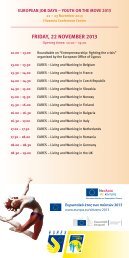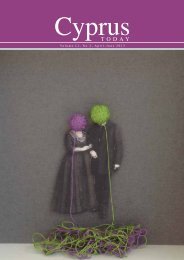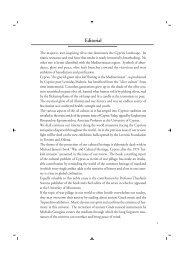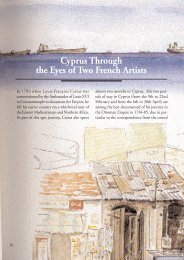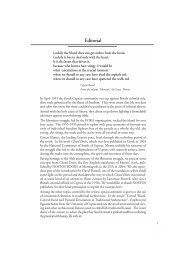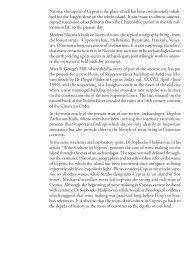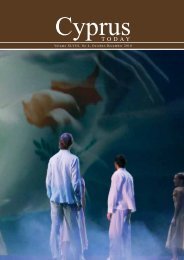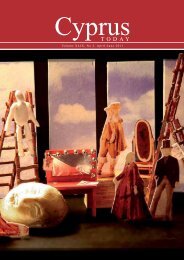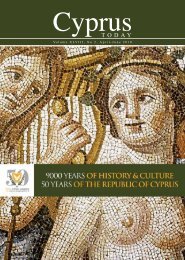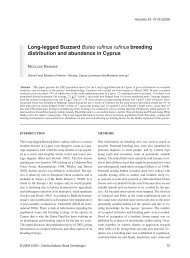Create successful ePaper yourself
Turn your PDF publications into a flip-book with our unique Google optimized e-Paper software.
The Garbage Sound Civilization II by Katerina<br />
Attalidou and Stephanos Karambambas<br />
offers, in the lightness of its<br />
structure, a dreamland out of context.<br />
The visitor finds himself in front of the door<br />
of a closet or a house. The structure made<br />
of a plastic bag fills with air, creating a sensorial<br />
space completely different from the<br />
external world, which consequently reflects<br />
the contrasts of the experience. For the spectator<br />
this is an initiatory and entertaining<br />
journey, during which he feels mostly<br />
lost.<br />
Nicos Charalambides has built for <strong>Paris</strong><br />
Ledras Barricade, recalling the recent history<br />
of Cyprus as well as its political and<br />
geographical division. After forty-eight years<br />
of blocking Ledra Street, this barricade has<br />
just been destroyed, rekindling hope for<br />
contact between Greek and Turkish Cypriots.<br />
On the structure, a video replays images<br />
presented in the news during the historic<br />
demolition of the barricade, which has now<br />
been transformed by the artist into an alternative<br />
space. This structure refers to all the<br />
attempts undertaken by the artist since the<br />
1980s; baptized Social Gym, they introduce<br />
the concept of a museum perceived – in the<br />
ancient Greek sense of the term – as a lab-<br />
40<br />
<strong>Paris</strong> / <strong>Chypre</strong><br />
Androula Michael and Fabrice Flahutez<br />
During the official week dedicated to Cyprus, in the framework of the European<br />
cultural season, Cypriot artists were given a unique opportunity to show<br />
their work in the heart of <strong>Paris</strong>.<br />
oratory of ideas, a place of meeting, like the<br />
"agora". In Charalambides’ structure we<br />
can also see his concept of a Rumbling Museum,<br />
a mobile and nomadic installation virtually<br />
planted in politically charged places,<br />
like the Gaza Strip, the occupied airport<br />
of Nicosia or Ireland, in order to function<br />
as a platform of contemplation and interaction<br />
between individuals. Involved in a<br />
dialogue with architecture and famous buildings,<br />
he reevaluates our ties to the social<br />
environment.<br />
Melita Couta proposes an installation in<br />
the form of a kiosk. It will have several openings<br />
at the sides, in order to enable the<br />
visitors to have a look at its interior. The<br />
kiosk reveals to the public numerous copies<br />
of Aphrodite’s statue and other objects. It<br />
will also function as a theatre, since an actor<br />
will be performing inside it. This work is<br />
based on the exchange with the people and<br />
creates a link between the interior and the<br />
exterior environment. Aphrodite’s small statues,<br />
which are placed in the interior side of<br />
the structure, have a very important role to<br />
play when it comes to attracting tourists.<br />
These statues are meant to lure people closer<br />
to the artist, enabling him to communicate<br />
with the public.
Melita Kouta, Installation, detail<br />
41
42<br />
Yioula Hadjigeorgiou, “Aphrodite's Bath”, 2008<br />
Katerina Attalides & Stephanos Karabambas, “The Garbage Sound Civilization II”, 2007
Yioula Hadjigeorgiou very often uses women<br />
and water as a regular theme in her work.<br />
In her play Knife in Water she expresses the<br />
prevalence of duality and the never-ending<br />
fracture. Everything in this world is destined<br />
to be terminated, but still it is always in search<br />
of completion. This prolongation in mythology<br />
is doubtful, whenever there is a thought<br />
implying that the world is divided into two<br />
parts. Knife in Water functions like a figure<br />
of speech, referring to interruptions and divisions.<br />
Passion and heartbreaks, the desire<br />
to follow tradition or to break free from it<br />
are moments full of ambiguity, when you<br />
have to put an end to something. Water is<br />
an essential element, which brings people<br />
together since this liquid remains entire even<br />
when it is split or when it comes apart; it<br />
reflects an image of something complete and<br />
entire. The myth referring to Narcissus expresses<br />
this human urge for preserving continuity.<br />
At the same time, the hero pays the price<br />
of his own destruction. It’s about separating<br />
art from its social aspect. In the video<br />
called Aphrodite’s Baths, a drop falls every<br />
10 seconds on salt, leading slowly but surely<br />
to its extinction. This is something that<br />
should be explained in its metaphorical sense,<br />
for it expresses a rather complex reality. Does<br />
a loss of a face imply the death of a human<br />
being? This is the question given by the artist.<br />
In the process of the extinction of a body,<br />
where lies the profound meaning of the poet,<br />
Yioula Hadjigeorgiou, emerges a shapeless<br />
and meaningless trace of a past existence. She<br />
actually wonders about the relation existing<br />
between life and death. The only act of<br />
resistance in this process of extinction is<br />
the creation of a masterpiece, for even body<br />
and spirit are condemned to vanish. The ques-<br />
tion of eternity emerges here once again.<br />
Phanos Kyriacou exhibits caps with the following<br />
slogan written on them: I LOVE<br />
CYPRUS AND CYPRUS LOVES ME. In fact,<br />
the caps will be sold for a symbolic amount<br />
of money (ten cents each). This attempt aims<br />
at initiating dialogue and exchange with visitors<br />
and potential buyers. The ultimate goal<br />
is to establish contact with the "tourists" who<br />
tend to buy stereotyped souvenirs from every<br />
country they visit. There will be about a thousand<br />
caps with various fluorescent colours.<br />
In this way, the souvenirs will be turned into<br />
parasite elements of a <strong>Paris</strong>ian culture, making<br />
us wonder about the cultural and geographical<br />
boundaries in this era of globalisation.<br />
Lia Lapithi explains in her video called Recipe<br />
for Marinated Crushed Olives how to prepare<br />
this homemade recipe. In fact, the olives<br />
are crushed and are then left to marinate in<br />
lemon and salt. The olives are being crushed<br />
on a bed of newspapers and magazines. There<br />
is a dialogue between this traditional recipe<br />
and the pictures of the newspapers placed<br />
underneath some jars; a dialogue of deaf people,<br />
blending History with political and social<br />
problems of today. The second video chosen<br />
here is entitled It’s Spring-time and I Still Live<br />
in Cyprus. It shows Ledra Street, used in<br />
figurative sense to describe the recent events<br />
on the island. In this work we notice an entertaining<br />
tone, a pleasant way of dealing with<br />
events, exactly like Cypriots do in real life.<br />
The third video selected here, Grade IV, shows<br />
a child writing frantically on some sheets of<br />
white paper during a long film sequence.<br />
When the camera approaches the child’s shoulder,<br />
we notice that the child keeps copying<br />
43
44<br />
Phanos Kyriakou, “Parasitic Souvenir”, 2008<br />
Anber Onar & Emin Cizenel, “Argilla Animate Cypria”, 2008
the same sentence, "I will love my Neighbour",<br />
hundreds of times, as if it has been<br />
punished. In the context of social criticism<br />
against an education system that forgets how<br />
fragile liberty and understanding really are,<br />
Lia Lapithi invokes childhood innocence<br />
as an allegory of our societies.<br />
Panayiotis Michael chooses an urban space<br />
to place some sign boards which have certain<br />
characteristics: the observer is supposed<br />
to get lost since these signs cannot be used<br />
in an instructive way. Remember Me constitutes<br />
a possible way, but is in fact a secondary<br />
one, or an indirect way to memory<br />
containing certitudes instead of a precise path<br />
to follow, which constitutes an aim in<br />
itself. The signs are there to express the liberty<br />
of meeting by chance someone’s past.<br />
The artist exhibits a series of drawings in a<br />
steady line. The theme functions like infinite<br />
excrescences allowing to the drawing<br />
<strong>Paris</strong> / <strong>Chypre</strong><br />
to open up itself beyond the expected framework.<br />
After having created some sculptures of<br />
various shapes, Anber Onar and Emin Cizenel<br />
will classify them and give them a name showing<br />
a scientific appearance, establishing<br />
this way their genealogical provenance. When<br />
this preparatory work comes to an end, they<br />
will then accomplish a book of artists, where<br />
nature will be invented again; this series entitled<br />
Argilla Animate Cypria lies between reality<br />
and imagination. It describes the possibility<br />
of living in a world where there are<br />
no habits, just poetry. The spectator may take<br />
the book with him after filling in a paper.<br />
The video of Christodoulos Panayiotou,<br />
Slow Dance Marathon, is the living proof of<br />
a performance he had already tested in Thessalonica<br />
and in Tel Aviv. This performance<br />
invites the public to contribute by participating<br />
in a slow dance marathon. This work<br />
The Ministry of Education and Culture in Cyprus responded to the invitation of the French<br />
Ministry of Culture and Communication to participate in an innovative project marking the<br />
French Presidency at the European Union. The event called “A European Cultural Season”<br />
brings together the cultural and expressive diversity of the European Union member states.<br />
In this regard, the Cultural Services secured an intense presence of Cyprus starting with the<br />
Cyprus Week (28 July-3 August 2008) and continuing with other events organised in cooperation<br />
with the Embassy of Cyprus in <strong>Paris</strong> and with the participation of established Cypriot<br />
artists.<br />
Another event is the “Tandem” programme, conceived by the French Ministry, which seeks to<br />
put together activities in tandem with each member state. In line with this programme, two<br />
concerts, one in France and one in Cyprus with the music of the Cypriot composer, Kavallaris<br />
were held, with the participation of Cypriot and French musicians. The events are spread over<br />
the six-month term of the French Presidency, until December 2008.<br />
45
46<br />
Panayiotis Michael, “Remember Me”, 2005-2008
is quite interesting for various reasons:<br />
first, it is about the meeting of the Other.<br />
Anonymous people can establish a contact<br />
despite their characteristics which might constitute<br />
a risk for them. This precise risk<br />
taken by the dancer allows him to reinvent<br />
the essence in his art, which is the expression<br />
of emancipation for him. Verbal expression<br />
does not seem to be a decisive factor<br />
of choice anymore. There are a number of<br />
parameters interfering, such as body language<br />
or music, which encourage people to go on<br />
with this experiment. Slow Dance Marathon<br />
becomes a space of relations, creating an<br />
impossible setting, but at the same time a<br />
poetic of two human beings in an artistic<br />
experiment.<br />
Andreas Savva, “Digestive Tract”, 2000<br />
Andreas Savva is dealing with the notion of<br />
space the same way a writer uses sheets of<br />
paper. He writes in this network of strings<br />
the stories and the state of migrants or refugees.<br />
He entraps everyday objects, transforming<br />
them into "objects of sculpture" and disengaging<br />
them from their original function. While<br />
Andreas Savva is going under this process of<br />
giving a new identity to his objects, he also<br />
examines the relation existing between a specific<br />
object and the way we perceive our life.<br />
He refers to his own life as a refugee; objects<br />
of daily life are trapped in this network of strings<br />
just like the existence of some characters in the<br />
story. We have a three-dimensional expression<br />
of time, carrying souvenirs, but also objects<br />
and people. This network of strings shows the<br />
47
48<br />
Socrates Socratous, “Naja Haja“, 2008<br />
TWO / FOUR / TWO, “Reaction“, 2002
confusion and the complexity in the relations<br />
we have with material things that seem<br />
to us as perpetual but in reality they are transitory<br />
and temporary. The only thing remaining<br />
is the material, which constitutes our memory<br />
and our past.<br />
Socrates Socratous uses a palm tree in his<br />
work, some photographs of houses, a video<br />
showing a cobra and its charmer, all of which<br />
represent a legend within reality. He has been<br />
inspired by a rumour according to which poisonous<br />
snakes have been mistakenly imported<br />
to Cyprus through some palm trees. In<br />
fact, this is a story regarding involuntary<br />
exchange. People’s boundaries seem to come<br />
out of their own imagination and these boundaries<br />
cannot resist dangerous cobras like<br />
the ones brought on the island on exotic palm<br />
trees destined to decorate luxurious villas.<br />
Yiannis Toumazis notices an identity card<br />
at the war museum of Istanbul, which was<br />
lost and forgotten there. When he reads<br />
the name on this identity card he decides<br />
to publish an article in a Cypriot newspaper,<br />
addressing a letter to an unknown person,<br />
just like a bottle in the sea, aiming at giving<br />
life to a past. However, this letter will arrive<br />
at its destination. This man lives in France<br />
and has been working in the country for quite<br />
some time now. Yiannis Toumazi’s work is<br />
the poetry through time which goes beyond<br />
boundaries and distance.<br />
The work Reaction by TWO/FOUR/TWO<br />
(Costas Mantzalos and Constantinos Kounnis)<br />
features two videos on a monitor facing<br />
a mirror. From the glass front of the installation,<br />
viewers can watch both videos simultaneously<br />
through the mirror. The work investigates<br />
the limits of interaction between the<br />
image and the viewer by capturing the latter’s<br />
expression. A new perspective of "Self"<br />
emerges from the deconstruction and manipulation<br />
of the body. During this interactive<br />
process, a three-way dialogue takes place<br />
between reality (the viewer), simulation (the<br />
reflection in the mirror) and the moving<br />
image (the video monitors). The work forces<br />
the viewer to become aware of his own presence<br />
in a visual field that is outside of him.<br />
Bearing always in mind Cyprus’ political situation,<br />
all modern artists promote the social<br />
and political reality of the island from a<br />
distance, bringing in criticism and even<br />
humour or irony, escaping in this way from<br />
a literal speech.<br />
Periklis Timotheou, “Summer in Cyprus“<br />
49
50<br />
Awards for Cypriot Film Directors<br />
Local film Director, Yiannis Economides was<br />
honoured with a top accolade by the Greek<br />
Ministry of Education and Culture last July.<br />
Economides’ 2007 film "Soul Kicking" (Psichi<br />
Sto Stoma), financed by the Cyprus Ministry<br />
of Education and Culture received the award<br />
for Best Film in 2007. The Greek Ministry<br />
of Education and Culture announced that<br />
the Panhellenic Cinema Critics Union (PEKK)<br />
had voted for this release, along with Four<br />
Months, Three Weeks and Two Days by Cristian<br />
Mungiu in the foreign film section, as<br />
the best films of 2007.<br />
The annual review of PEKK Cinema 2007,<br />
considers the film worthy because of its genial<br />
power of deduction, a feature rarely attained<br />
in the Greek cinema.<br />
"The deduction is not only in the image –<br />
with action very often viewed outside steady<br />
gros plans – but also in the speech itself. This<br />
sounds somewhat absurd given that swearing<br />
is heard falling like downpour, even overlapping<br />
at times.<br />
"Yet, this is automatically deductive as the<br />
speech is on its own surreal. A very precise<br />
choice made by Economides who refuses the<br />
dramatic ease of explaining per person, but<br />
makes others speak in the same intensity, as<br />
a symbol of the protagonist’s oppressive environment."<br />
Most reviews are highly appreciative. They<br />
extol: "such courageous interpretations which<br />
overcome the theatrical pomposity with<br />
remarkable intensity" or commend the "harsh<br />
but true image of a section of the popular<br />
class as seen through the story of a pitiful,<br />
oppressed worker".
All in all the reviews consider it "the most<br />
astonishing and original film of recent years"<br />
and also "a source of great surprise and joy,<br />
as it reveals that the Greek cinema is still<br />
alive."<br />
Cypriot film director, Kyros Papavassiliou<br />
was awarded the Prix d’Innovation for his<br />
short film "Sparrow’s Name" (To onoma tou<br />
spourgitiou). Selected among 3,000 films to<br />
represent Cyprus at last year’s International<br />
Competition at the Cannes Film Festival, the<br />
film was awarded the prize at the Tetouan<br />
International Mediterranean Film Festival in<br />
Morocco.<br />
Kyros Papavassiliou was born in Nicosia in<br />
1972. He studied Philosophy and Music in<br />
the USA.<br />
The film deals with the absence of real identity<br />
in modern society and the inability to<br />
name things, in relation to substance. It is a<br />
unique mixture of abstract concepts and<br />
rational arguments reflected in a poetic image<br />
and in the abstract rhythm of the film.<br />
The plot is centered on a young man who<br />
somehow loses his name and goes to a specialist,<br />
a "nameologist", to get a new one.<br />
The First Prize for the documentary film at<br />
the 31st Drama Film Festival was awarded<br />
to the film “Transgression” produced by Cypriot<br />
directors Bambos Kouzalis and Costas<br />
Karayiannis. The documentary, subsidized<br />
by the Cultural Services of the Ministry of<br />
Education and Culture, relates the true story<br />
of Stelios Pisis, a young composer nailed<br />
to his bed.<br />
Within the framework of the same Festival,<br />
Constantinos Yiallourides' short film “Instructions<br />
for Use” was awarded three prizes: the<br />
Greek Film Centre Prize, the New Talent<br />
FNAC First Prize and the Panhellenic Union<br />
of Film Critics (PEKK) Prize for his original<br />
and youthful approach.<br />
51
52<br />
Cyprus has participated in the European<br />
Heritage Days since 1995.<br />
Established by the Council of Europe<br />
in 1991, this institution’s main goal is<br />
to enable the wider public to become<br />
acquainted with and appreciate the<br />
architectural and cultural heritage<br />
of their countries.<br />
What is really special about this<br />
occasion is that historic and traditional<br />
sites, especially those that are otherwise<br />
inaccessible, are opened to the public.<br />
Furthermore, a significant number<br />
of other related events like exhibitions,<br />
lectures, music and cultural<br />
events are organised, aiming at making<br />
the public familiar with the traditions<br />
of each area.<br />
In Cyprus, the European Heritage Days<br />
(EHD) is an event organised by the<br />
Department of Town Planning and<br />
Housing (Ministry of Interior) in cooperation<br />
with the Cyprus National<br />
EHD Committee and various public<br />
and private organisations active in the<br />
field of heritage.<br />
The Theme<br />
This year’s theme presented the architectural<br />
heritage situated along the buffer zone<br />
that divides the city of Nicosia. The cultural<br />
richness of the area, so close and yet<br />
so inaccessible, was presented for the first<br />
time through walking tours and exhibitions.<br />
European
Heritage Days<br />
The buffer zone area within the walled city<br />
53
54<br />
The aim was to explore the ways in which<br />
common heritage unites people from different<br />
communities and builds communication<br />
bridges between them. At the same<br />
time, the relationship between architectural<br />
creation and the human element is highlighted<br />
as this is indispensible for the<br />
existence and preservation of the built environment.<br />
The Buffer Zone<br />
For 34 years, the island of Cyprus has been<br />
divided and nowhere has this been more<br />
obvious than within the capital city of<br />
Nicosia. The UN controlled buffer zone<br />
cuts through the historic walled city leaving<br />
a huge part of it totally unprotected<br />
from the elements of time. The effects have<br />
been devastating.<br />
Within the walled city, the buffer zone runs<br />
approximately 1.5 km in length and passes<br />
through several neighbourhoods such as<br />
Paphos Gate (Porta Domenico), Karamanzade,<br />
Ayios Andreas, Nebet Khane,<br />
Phaneromeni, Selimiye (Ayia Sophia),<br />
Omeriye, Chrysaliniotissa and Ayios Kassianos.<br />
The buildings in the buffer zone<br />
stand on approximately 10% of the total<br />
area of the walled city. In this highly restricted<br />
area within the city walls, beautiful<br />
medieval churches, elegant neoclassical<br />
buildings, traditional houses, schools, shops<br />
and workshops are falling apart due to neglect.<br />
This was the part of the city that had<br />
been the focal point of activity, social life<br />
and trade. Since 1974, this historic area has<br />
been subjected to an accelerating deterioration<br />
process.<br />
History<br />
During the medieval period (12th to the 15th century), Pedieos River ran through the<br />
ancient walled city in an east-west axis, via<br />
an old course that is now used as the<br />
city’s underground rainwater drainage and<br />
bridges connected the two parts of the city.<br />
The famous medieval market extended<br />
along the river and was the vibrant hub<br />
of commercial transactions between Europe<br />
and the Near East. Luxury textiles, such as<br />
silk, linen, the "drap d’or de <strong>Chypre</strong>", as<br />
well as other precious items such as silver<br />
and gold were among the items produced,<br />
crafted and exported.<br />
During the Venetian period (15 th to 16 th<br />
century), the old medieval fortified walls<br />
were replaced with newer, stronger walls<br />
and the course of the river was diverted
to a new bed outside the walled city. These<br />
walls and their eleven heart-shaped bastions<br />
have survived to this day. The busy market<br />
area traversing the centre of the walled city<br />
also survived.<br />
Throughout the Ottoman period and the<br />
subsequent British colonial period (16th to<br />
20th century), the bazaar remained along<br />
the east-west axis and flourished to become<br />
the centre of social as well as commercial<br />
life. The bazaar still hosted particular trades,<br />
like the shoemakers and the copper traders,<br />
who later gave their names to streets where<br />
these trades were practiced.<br />
Nicosia Master Plan<br />
The Nicosia Master Plan (NMP) is a bicommunal<br />
project that promotes the revitalisation<br />
of the walled city. Greek Cypriot<br />
and Turkish Cypriot town planners, architects,<br />
engineers, sociologists and economists<br />
have been working under the umbrella of<br />
the UN planning the development policies<br />
for the wider area of Nicosia.<br />
The buffer zone has been identified by<br />
the NMP as the most important "uniting"<br />
area for the functional integration of the<br />
city and its development should assume its<br />
original role as the hub of activity of the<br />
walled city.<br />
Between March 2001 and June 2003, the<br />
a NMP team carried out a survey which<br />
recorded the buildings within the buffer<br />
zone, surveyed their structural condition<br />
and examined possible measures to save<br />
threatened buildings and halt their deterioration.<br />
The team consisted of eight Greek<br />
Cypriot and Turkish Cypriot architects and<br />
engineers who worked together on a daily<br />
55
56<br />
basis in the buffer zone.<br />
Architectural drawings in electronic format<br />
were prepared for 238 buildings or group<br />
of buildings within the walled city and for<br />
24 detached buildings to the west side of<br />
the city, outside the walls. The evaluation<br />
of the architectural value of each one of the<br />
238 buildings concluded that 80% of these<br />
buildings were listed as monuments, buildings<br />
of exceptional architectural value and<br />
environmental value. At the same time, the<br />
poor structural condition of the buildings<br />
pointed out the need for urgent intervention<br />
in order to restrain the accelerated deterioration.<br />
The experience was<br />
absolutely amazing. Apart<br />
from architectural analysis<br />
and survey of the buildings,<br />
the team members experienced this historical<br />
part of their town which in essence<br />
was inaccessible, even "dead" to them,<br />
although in reality very much alive, living<br />
in parallel with the two parts of the divided<br />
city. Moreover, the project sent a positive<br />
message for a peaceful coexistence in<br />
Cyprus as the daily contact of the team members<br />
from both communities provided the<br />
opportunity to co-operate and build lasting<br />
friendships.<br />
The members of the project team were: Agni<br />
Petridou – Architect and Town Planner –<br />
Supervisor, Gul Oztec – Architect – Supervisor,<br />
Eleni Petropoulou – Senior Architect,<br />
Selen Avkan – Senior Architect, Osman Yilmaz<br />
– Senior Civil Engineer, Simos Droussiotis<br />
– Junior Architect, Vasiliki Ioakim –<br />
Junior Architect, Andri Sofroniou – Junior<br />
Architect, Asli Aker – Junior Architect, Fatma<br />
Terlik – Junior Architect, Osge Osbekoglu<br />
– Junior Architect.<br />
Some Outstanding Buildings<br />
Ayios Iakovos Church<br />
Byzantine church dating to the 15th-16th<br />
century with features which were added later,<br />
such as the steeple and built-in ashlar<br />
stones. The church is covered with two intersected<br />
barrel vaults carrying the cupola, with<br />
eight windows. The arch of the Holy<br />
Place is semicircular.
Ayios Kassianos School<br />
This is a complex of two neoclassical buildings<br />
of the beginning of the 20th century,<br />
identical in their original layout, but with<br />
interventions made later.<br />
Olympus Hotel<br />
Built at the beginning of the 20th century<br />
(1914), it was one of the most important<br />
hotels in the walled city. Classical elements<br />
decorate the façade. The ground floor, built<br />
for commercial use, had simple elements of<br />
decoration (pilasters-Ionian capitals) while<br />
the first floor, occupied by the hotel, had<br />
more complicated decoration elements such<br />
as pilasters, balconies and Roman-Corinthian<br />
cornices with modillions.<br />
Houses with "Kiosk"<br />
A number of houses within the study area<br />
bear the characteristic "kiosk" on their street<br />
façade, which stands as a cantilever on wooden<br />
modillions.<br />
The structure of the "kiosk" is wooden, with<br />
light structure walls, "dolma", with wooden<br />
parts and stone filling.<br />
57
58<br />
The kiosk is an element deriving from the<br />
Ottoman architecture, which developed according<br />
to the social structure of those times, which<br />
wants the women enclosed with restricted social<br />
activity only on the upper floor. Most of<br />
these houses were dwellings on the upper floor<br />
with commercial use on the ground floor.<br />
After the Ottoman period, the small windows<br />
of the façade were often replaced by larger<br />
openings decorated with neoclassical details.<br />
Emergency Support Measures<br />
Within the framework of the project, between<br />
December 2003 and November 2004, a<br />
number of emergency support measures were<br />
undertaken to stabilise buildings in need of<br />
repair. This difficult task was completed under<br />
the supervision of architects and engineers of<br />
the bi-communal NMP technical team, and<br />
contributed to rescuing a number of buildings.<br />
Common Vision<br />
According to the Nicosia Master Plan, "…The<br />
historic centre of Nicosia is an outstanding<br />
example of international architectural heritage.<br />
It is the heart of the city and it is irreplaceable….without<br />
it Nicosia would lose its identity."<br />
It is, therefore, of utmost importance that<br />
the Walled City be protected and enhanced, so<br />
that it can assume its proper role as an integral<br />
part of the city.<br />
A common scheme for the revitalization of this<br />
area needs to be implemented, with the participation<br />
of all interested parties that will lead<br />
to its development according to the principles<br />
and provisions of the Nicosia Master Plan.<br />
Photos: Katia Christodoulou
60<br />
The performance of DanceCyprus' latest<br />
production, Rhapsody, was an exciting evening<br />
of dance of true European standard achieved<br />
through sheer determination and hard work.<br />
The founders of DanceCyprus aspire to provide,<br />
what has long been missing in Cyprus;<br />
that is a professional company to entertain<br />
local audiences and to inspire dancers and<br />
choreographers.<br />
The programme included three distinct and<br />
new ballets. It began with Rhapsody in Blue<br />
by Gershwin, choreographed by Julien<br />
Ficely, who currently dances with<br />
Ballet de Lorraine. Dancers Justin<br />
Cumine, Sergio Giacomelli, Amy<br />
Lazarou, Sebastien Mari, Elsa<br />
Sabbatini and Galatia Savva<br />
were all exceptional and<br />
had a perfect<br />
interaction between<br />
them.<br />
Dance Rhapsody<br />
The second ballet, Une Nuit Blanche was<br />
also created by Ficely to celebrate the tenth<br />
anniversary of the Pafos Aphrodite Festival.<br />
Dancer, Elsa Sabbatini on music from<br />
Puccini's opera Madama Butterfly, poured<br />
out her entire soul portraying her passionate<br />
feelings with great physical agility. Together<br />
with her lover, danced by Sebastien Mari,<br />
they peformed a passionate “pas de deux”<br />
dance with undulating movements.<br />
The final ballet, Amoroso, was the highlight<br />
of the evening. It was brilliantly choreographed<br />
by Carolina Constantinou who is<br />
currently soloist with the Munich National<br />
Theatre. The contrapuntal music of Bach's<br />
Brandenburg Concerto was reflected by the<br />
dancers with their smaller, faster stylized<br />
movements. The game with the suspended<br />
balls, the recurring music of the drums before<br />
Edith Piaf's song burst, the dancers' dark<br />
shadows against the white background, and<br />
the cleverly designed<br />
costumes by Andy<br />
Bargilly - were simply superb!<br />
Carolina Constantinou displayed her artistry<br />
in this high quality production, a real celebration<br />
of dance.
Ministers of Culture at Versailles<br />
The Minister of Education<br />
and Culture, Mr Andreas<br />
Demetriou, attended the Informal<br />
Meeting of Ministers of<br />
Culture of the European Union<br />
at Versailles held between 21<br />
and 22 of July 2008.<br />
The main priority of the French<br />
Presidency in the domain of<br />
culture is the preservation and<br />
protection of cultural heritage<br />
and this was a subject for<br />
discussion at the meeting of<br />
Ministers. The Minister of Education and<br />
Culture stated that the Republic of Cyprus<br />
agreed with and supported the French<br />
Presidency’s priorities and emphasised that<br />
the protection of the cultural heritage is a<br />
matter of priority for the Cyprus Government.<br />
He noted that Cyprus, which has made a<br />
contribution over many centuries to the European<br />
cultural heritage, continues to be a victim<br />
of the theft and plundering of her cultural<br />
treasures which are in museums or private<br />
collections abroad. In this context, he<br />
asked that measures be taken to implement<br />
the relevant EU Directive on the return of<br />
Cultural Artefacts which have been illegally<br />
removed from the territory of member-states,<br />
as well as the implementation of the International<br />
Conventions of UNESCO.<br />
The Minister of Education expressed the support<br />
of Cyprus for the initiative of France to<br />
create the European Action for the European<br />
Heritage Label, in which Cyprus<br />
participates with four monuments.<br />
In this context he supported<br />
the creation of a digital<br />
network on the European<br />
Cultural Heritage to which<br />
free access by the citizens of<br />
the EU and other countries<br />
will contribute to the promotion<br />
of mutual recognition<br />
among all cultures.<br />
With the aim of promoting<br />
the access of young people<br />
to the cultural heritage of Europe, he suggested<br />
the introduction of a lesson common<br />
to all European schools for familiarising pupils<br />
with the cultural monuments, and their history,<br />
which are included in the programme<br />
"European Heritage Label". He further noted<br />
that the creation of a "European Cultural<br />
Passport" for young people, suggested by<br />
the French Presidency, could make a substantial<br />
contribution to this end.<br />
Within the framework of the Informal Meeting<br />
of Ministers of Culture at Versailles, the<br />
Minister of Education and Culture met the<br />
European Commissioner for Education, Culture<br />
and Youth, Mr Jan Figel. During their<br />
meeting, they exchanged views on matters<br />
of European interest as well as on matters<br />
of priority for Cyprus.<br />
Mr Demetriou extended an invitation to the<br />
European Commissioner to visit Cyprus for<br />
further talks and it was accepted. Jan Figel<br />
will visit Cyprus on 1 December 2008.<br />
61
62<br />
Countryside Documentary & Animated<br />
Film Festival<br />
Featuring more than 30 documentaries<br />
and animation films from all over the world,<br />
the Countryside Documentary and Animation<br />
Film Festival was held between 30<br />
July and 3 August 2008 for the seventh consecutive<br />
year in the picturesque stone-built<br />
village of Plataniskia, tucked away not too<br />
far from Pissouri.<br />
Organised by a number of Cypriot NGOs,<br />
"Views of the World" and the Hambis School<br />
of Printmaking, the festival aspires to mix<br />
education with entertainment in a typical<br />
Cypriot setting. As Yiorgos Tsangaris, Fes-<br />
tival Management representative put it "we<br />
hope that this small celebration of the arts<br />
in the village of Plataniskia will put a smile<br />
on everyone’s face as we share the infinite<br />
pleasure of creation. Our only wish is to lay<br />
the foundations of a creative future in the<br />
cradle of a healthy planet."<br />
Music, contemporary art, ecology, human<br />
rights, immigration and folklore as well as<br />
a panorama of animation short films and a<br />
comprehensive tribute to Czech animation<br />
constituted the range of themes in focus during<br />
this year’s festival.<br />
Committed to defending the arts and all they<br />
stand for with a hand picked selection of<br />
films, the Festival arouses the public’s mind<br />
through the eyes of important artists.<br />
In the section "Documentaries", the programme<br />
included films about well-known<br />
personalities such as the musical genius Manos<br />
Hadjidakis in the film The Mirror and the<br />
Knife directed by Demetris Vernicos or A.<br />
Tassos directed by Sotiris Lambropoulos unveiling<br />
the true expression and spirituality of the<br />
Greek printmaker, or Orhan Pamouk – The<br />
Antennae of Our Time by Angelos Kovotsos<br />
in which the Nobel Laureate gives an interview<br />
to the Greek public television.<br />
There were also documentaries about the<br />
troubled years of the 20th century and the<br />
problem of the refugees from Eastern Thrace,<br />
the Black Sea and Asia Minor brought to life<br />
in Troubled Years by Kyriaki Malama or the
movement of economical immigrants from<br />
Syria into Turkey and eventually into Cyprus<br />
struggling for a better quality of life in<br />
Hope Against Hopeless directed by Constantinos<br />
Patsalides.<br />
Twelve films were shown in the International<br />
Panorama of Animated Films with productions<br />
from Europe, Australia, the USA and<br />
Iran.<br />
The other two sections of the Festival were<br />
a "Tribute to the Czech Animation" and<br />
"Focusing on Illustration" introducing Gary<br />
Baseman’s rich world of emotions, ideas,<br />
humour and longing.<br />
The event combined open-air screening with<br />
an impressive array of printmaking, sculpting<br />
and animation workshops. The educational<br />
side of the Festival involved the participants<br />
in a creative process offered by the<br />
illustration workshop of American artist Gary<br />
Baseman where they had the great chance to<br />
become acquainted with the frightening<br />
absurdities and intensity of his work, his irony<br />
as well as his undeniable optimism in life.<br />
Born in Los Angeles in 1960, Gary Baseman<br />
has won an array of awards for his work in<br />
both TV and printed media.<br />
63
64<br />
Achilleas Lymbourides, one of<br />
Cyprus' earliest songwriters,<br />
playwright and journalist, died<br />
aged 88 in his hometown of Nicosia.<br />
A versatile and multitalented artist,<br />
Lymbourides also worked as a<br />
journalist and publisher, founded<br />
the first professional theatre in<br />
Cyprus and authored several books. In 1997,<br />
he was awarded the State Prize of Excellence<br />
in the Letters and Arts for his cultural<br />
contribution.<br />
His death occurred just as the Union of Cyprus<br />
Journalists was contacting him to organize<br />
an event to celebrate his creative output. It<br />
was announced that he will be honoured<br />
posthumously.<br />
Achilleas Lymbourides studied violin and<br />
music at the Greek Conservatory in Cyprus<br />
and later taught music himself at the National<br />
Conservatory of Nicosia and at the School<br />
for the Blind where he was the first to use the<br />
Braille system for the reading of music.<br />
A characteristic feature of his songs is that he<br />
uses the lyrics of Cypriot vernacular poets,<br />
such as Demetris Lipertis, Vasilis Michaelides,<br />
Costas Montis, Michalis Pashiardis Tefkros<br />
Anthias and others.<br />
One of his songs won a prize in a Prague<br />
Radio international competition in 1963. In<br />
Achilleas Lymbourides<br />
1917 - 2008<br />
1964, he gave a series of concerts<br />
with the Greek Opera and the<br />
Athens Symphony Orchestra,<br />
followed in 1969 by a performance<br />
of his works at the 2nd International<br />
Song Olympiad also held in Athens.<br />
He showed his interest in the theatre<br />
as early as 1942, when he established<br />
together with Phivos Mousoulides the “Lyrical”,<br />
the first permanent theatre company for which<br />
he wrote plays and social sketches, and naturally<br />
the music score.<br />
As concerns his interest in journalism, in<br />
1952 he started publishing the variety magazine<br />
“Fakos” (Lens), which was issued for eight<br />
years, while also working as a journalist for<br />
newspapers. He also wrote the book “A History<br />
of the Cypriot Journalism 1878-1960”.<br />
His other publications include “Justice during<br />
English Rule”, “English Rule in Cyprus” in<br />
two volumes, “A Street Encyclopedia of Cities<br />
and Villages of Cyprus”, “Five Prominent<br />
Personalities of International Literature”,<br />
“Cyprus and the Great War 1910-1920”, and<br />
“Cyprus in the Interwar Period”.<br />
Achilleas Lymbourides will be remembered<br />
mostly for the beauty and joy of his music<br />
which is being hummed by common folk<br />
today across the island.



